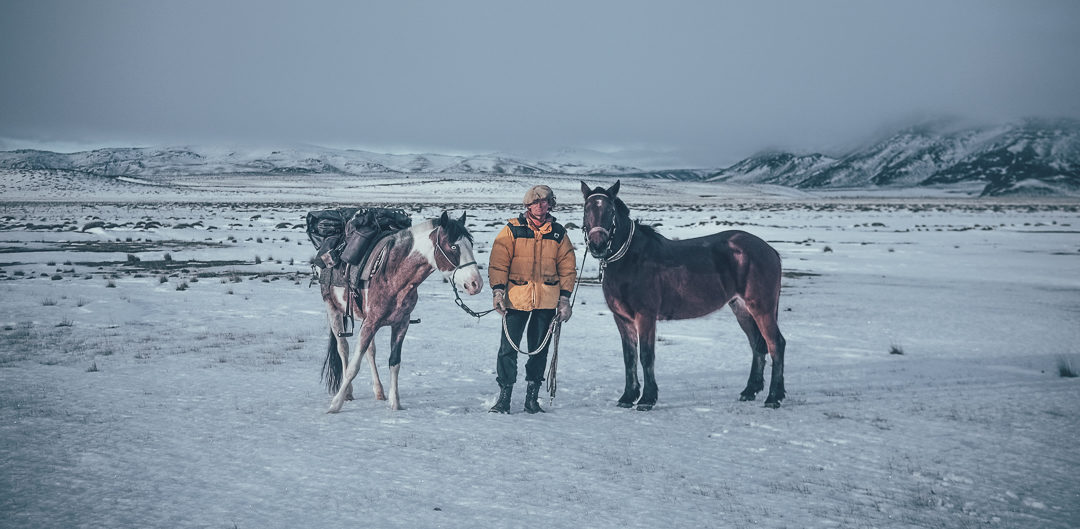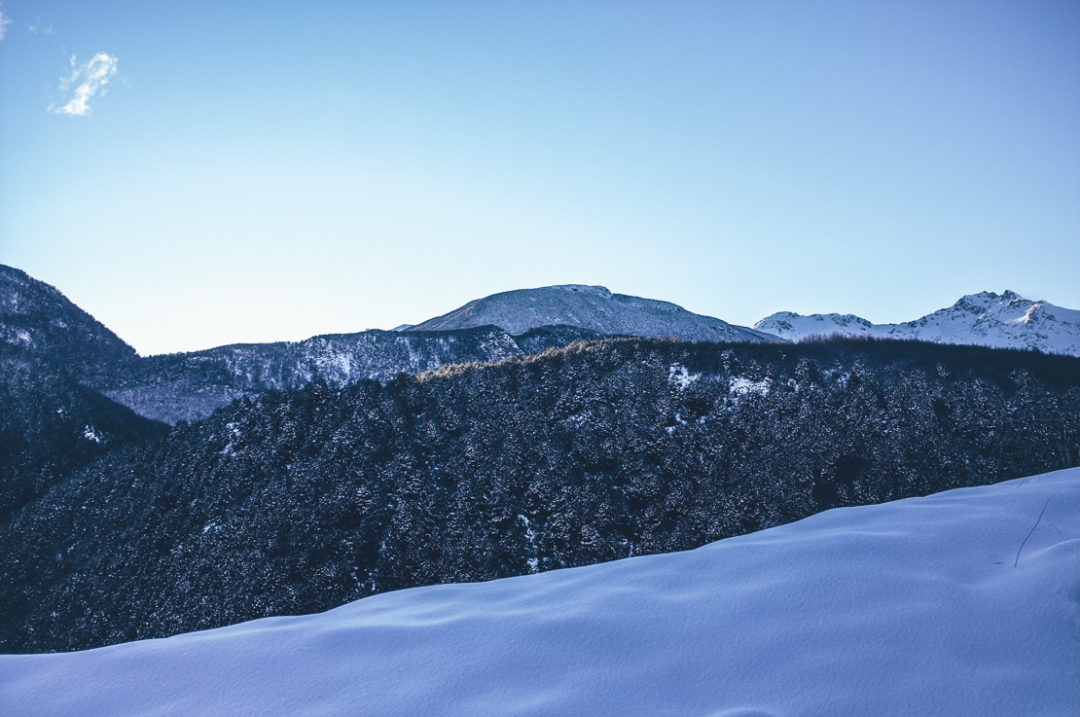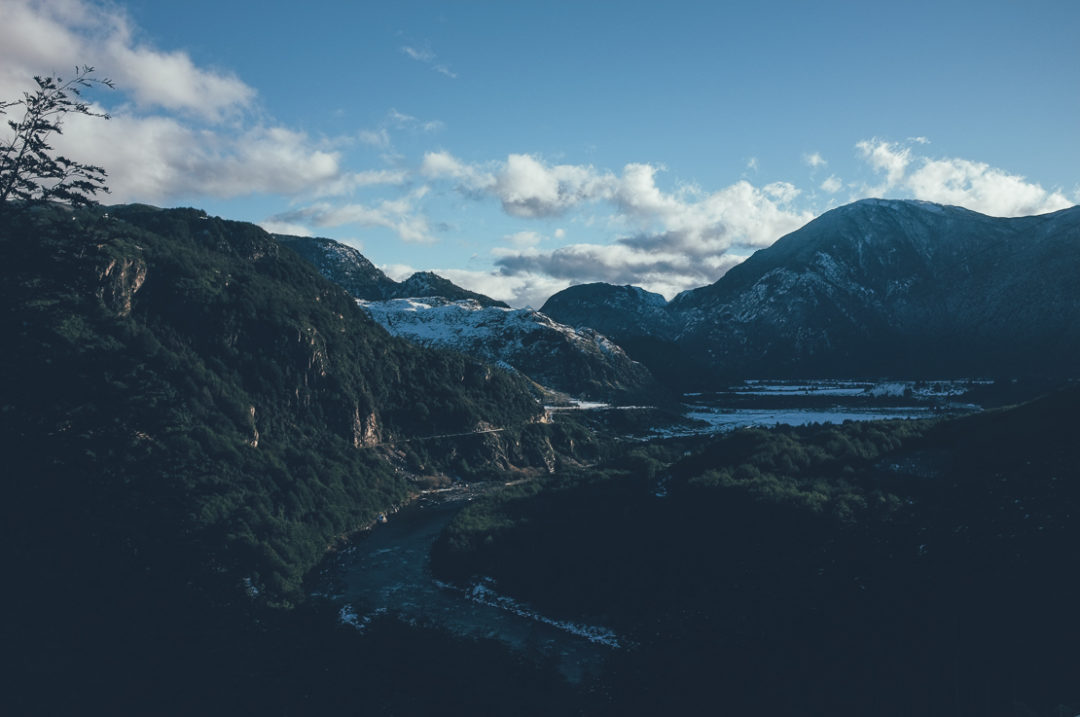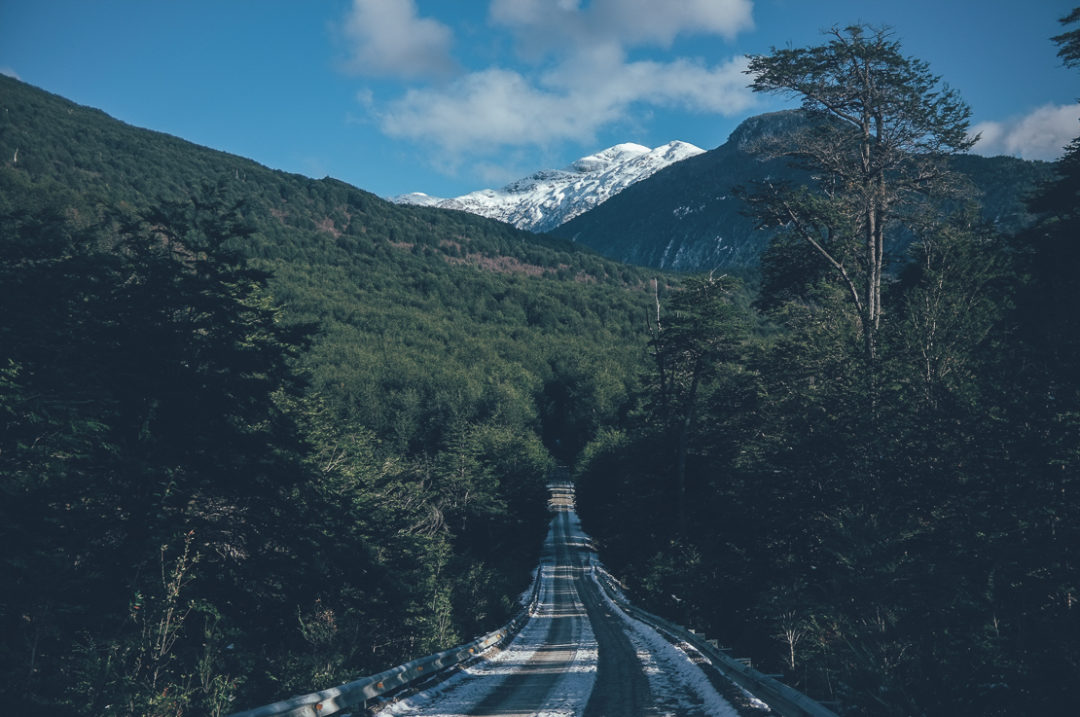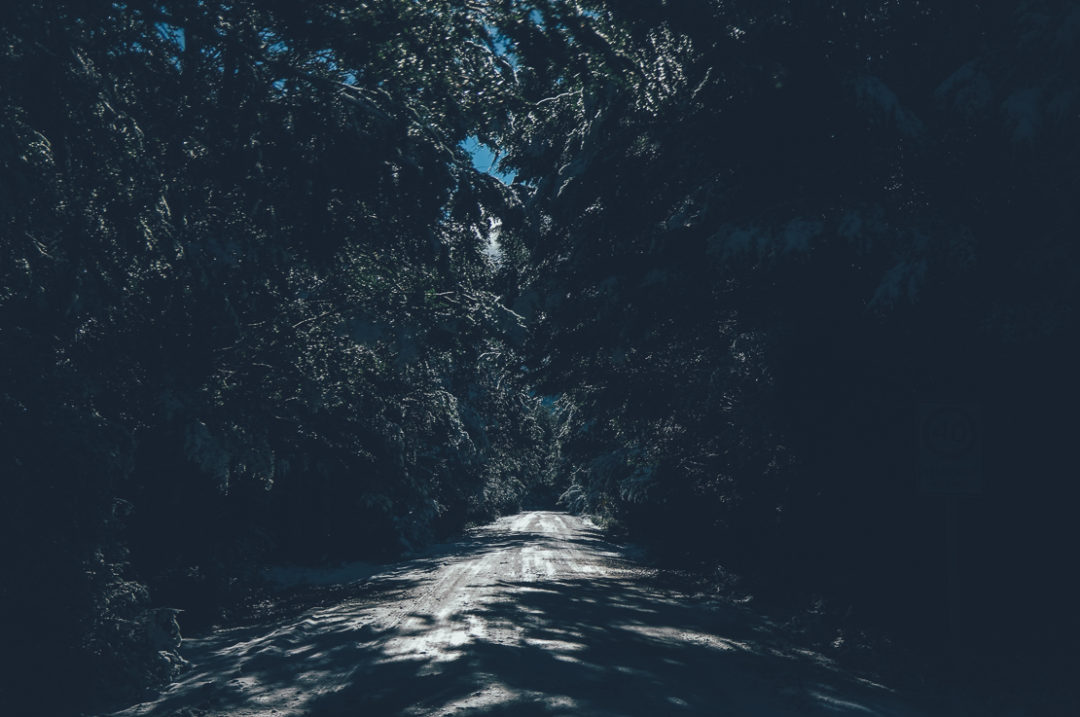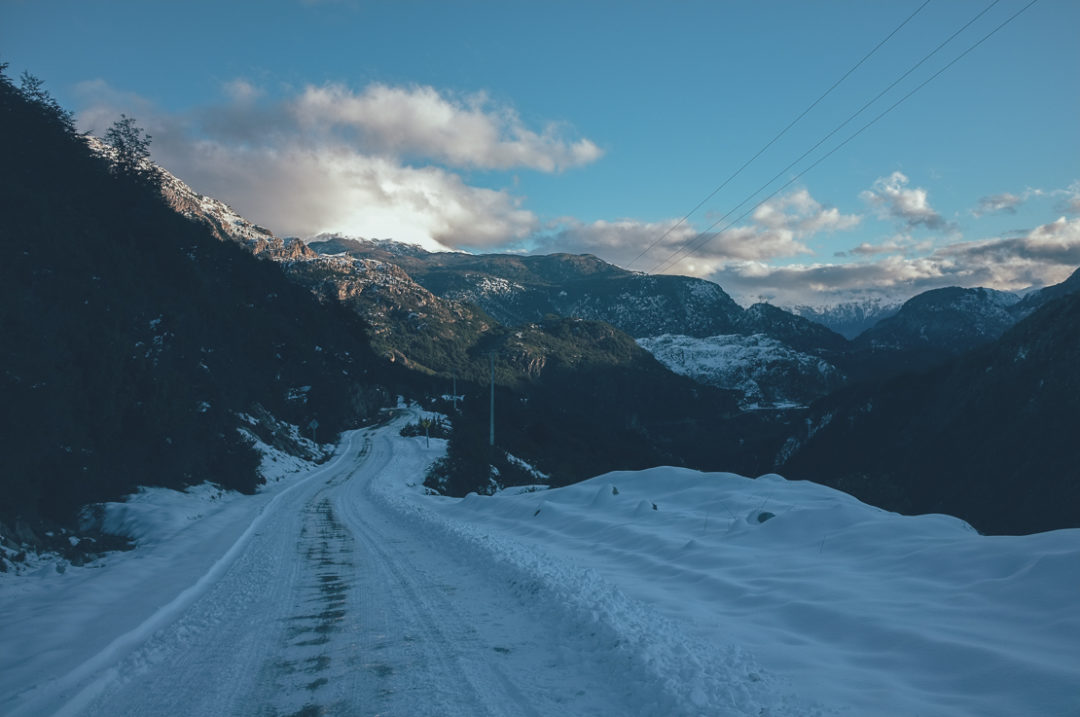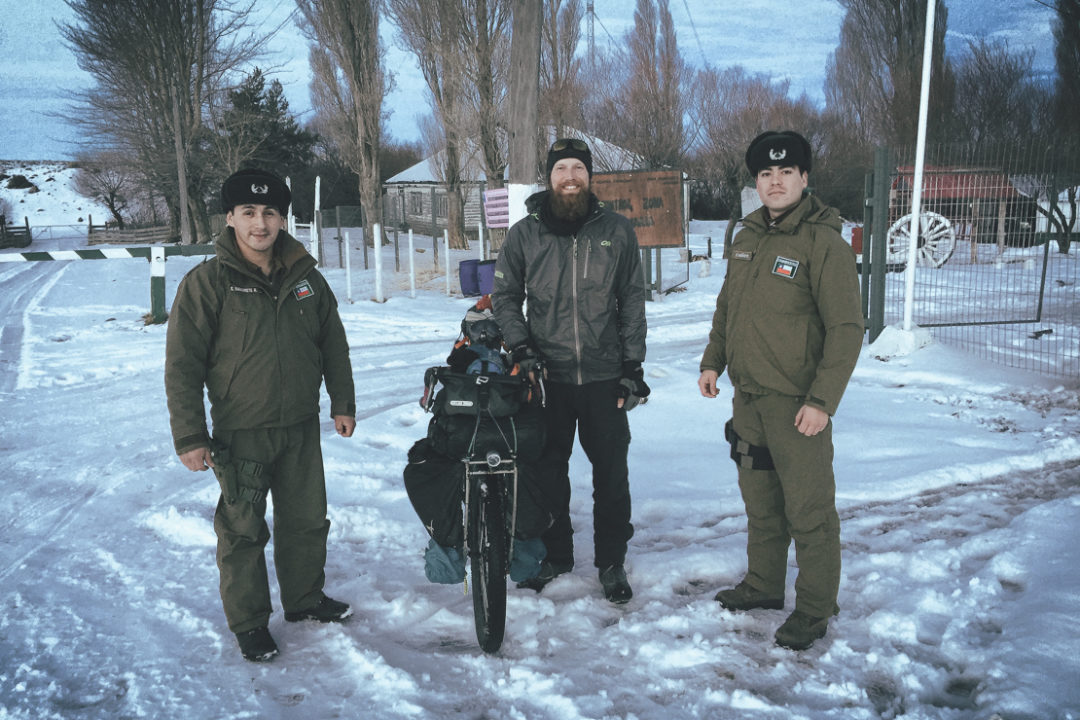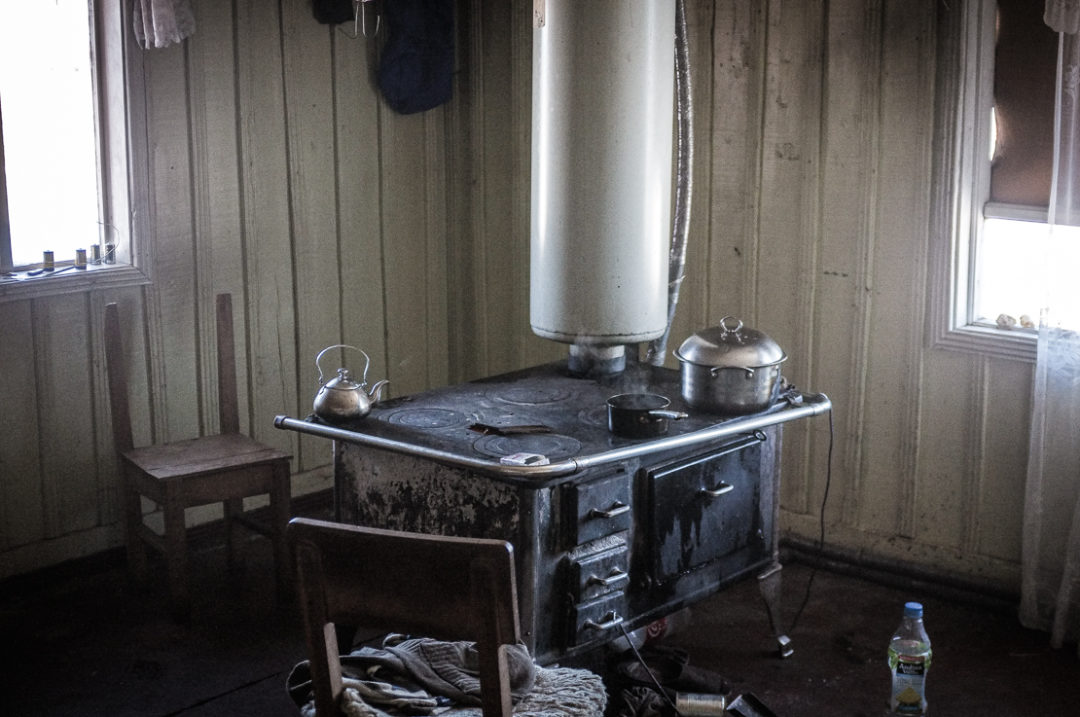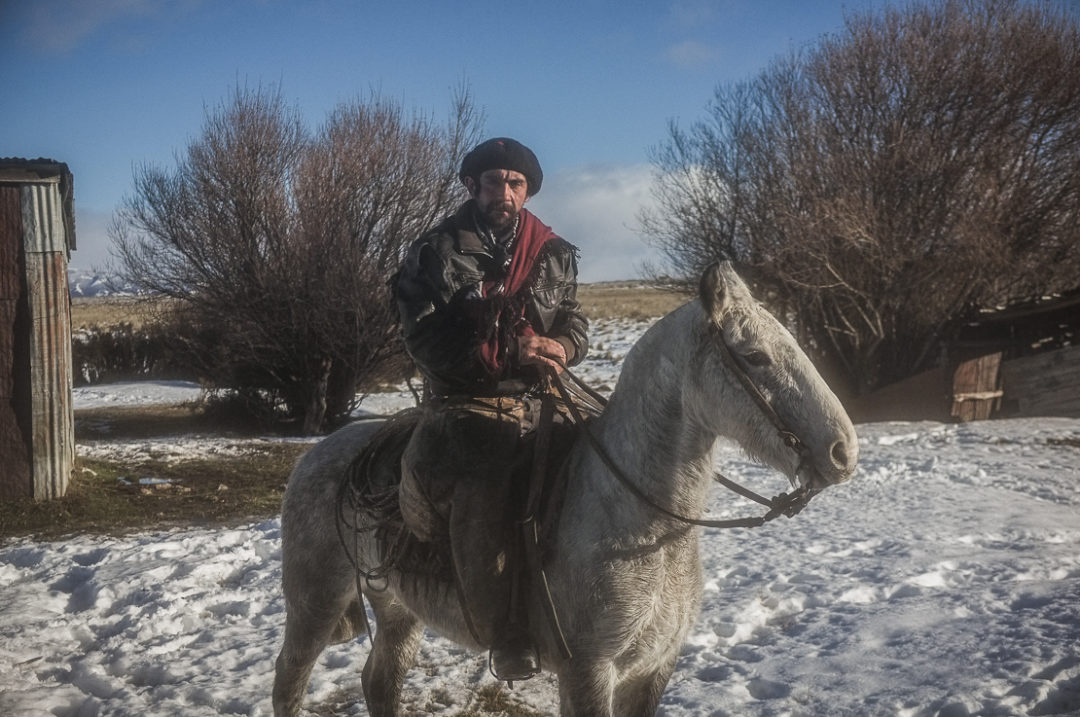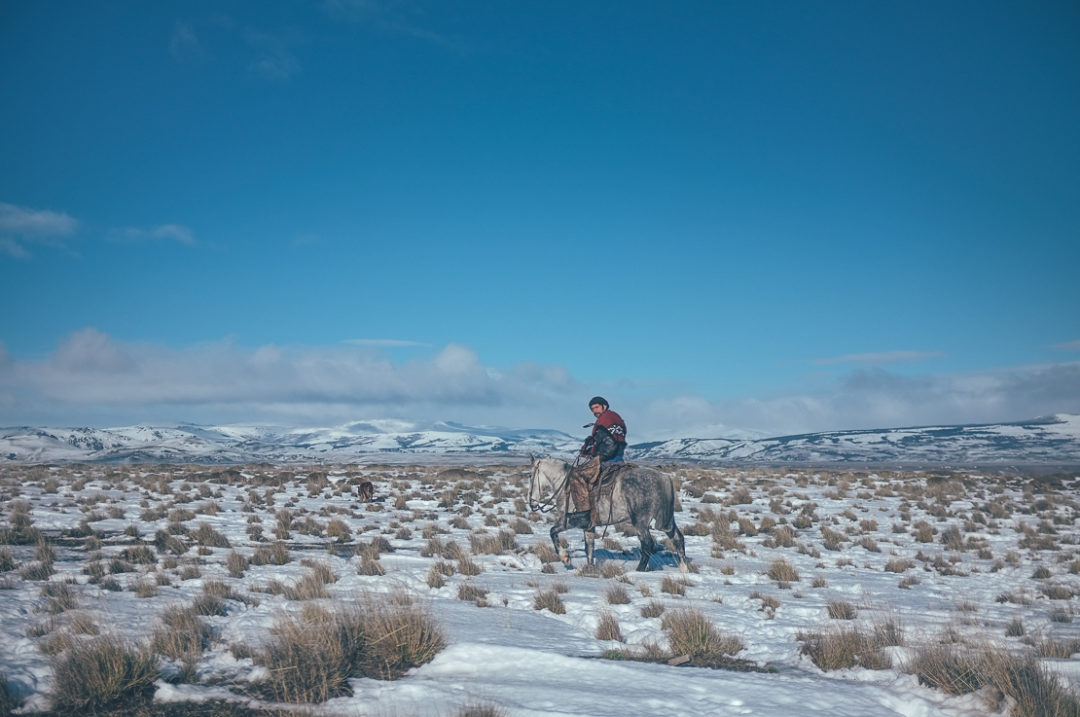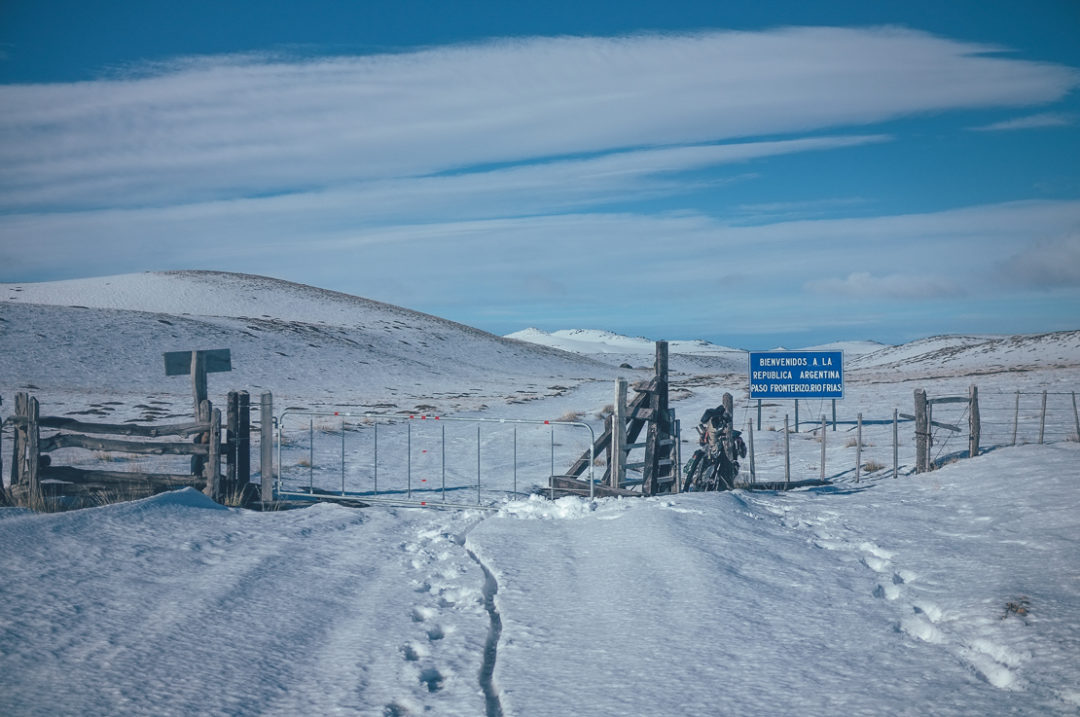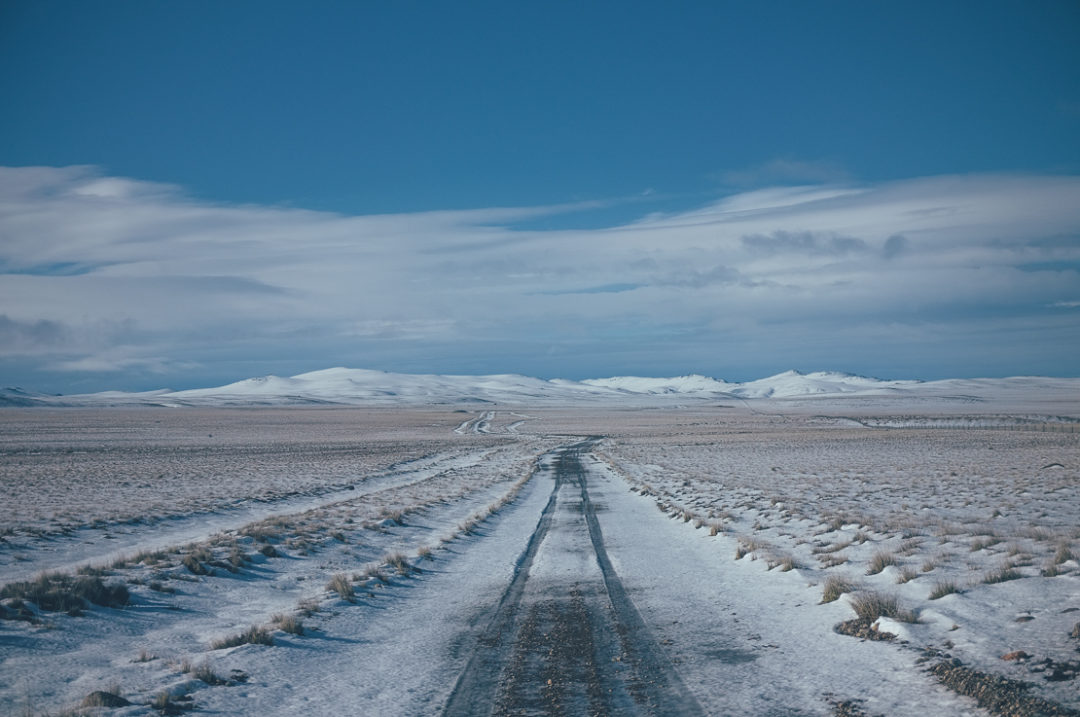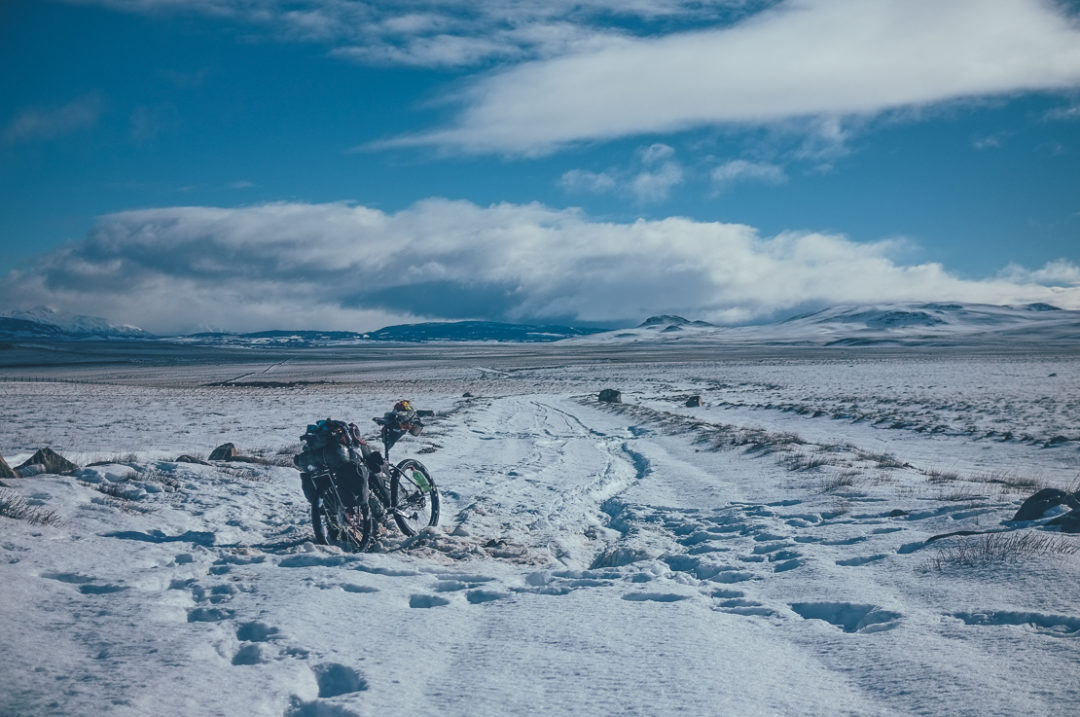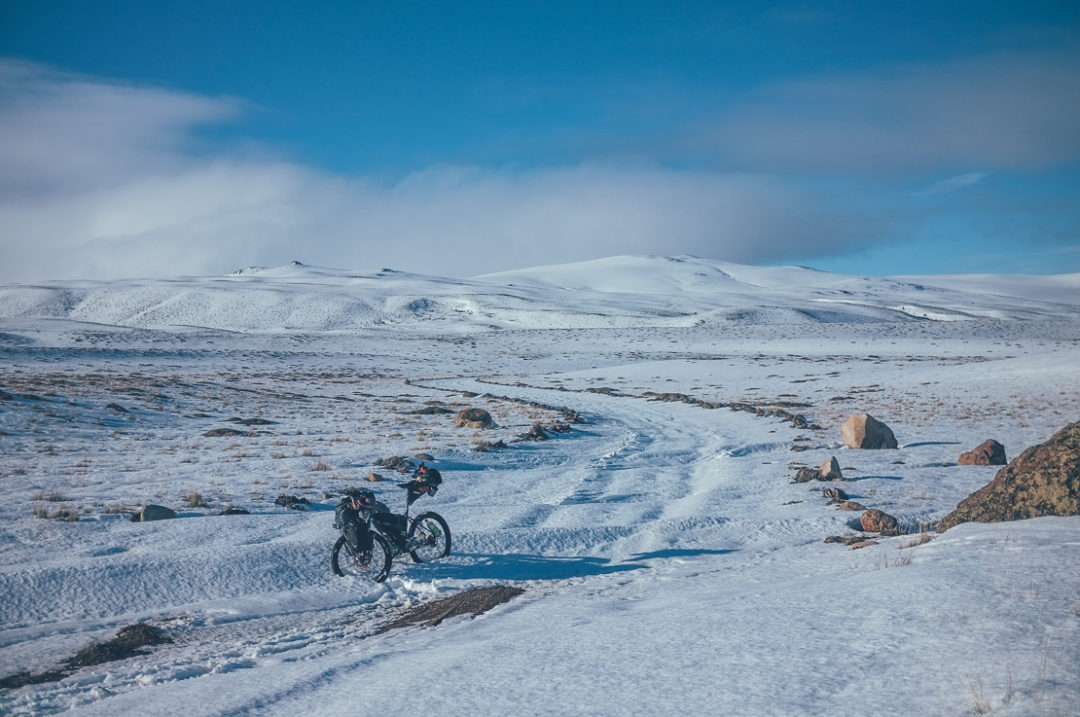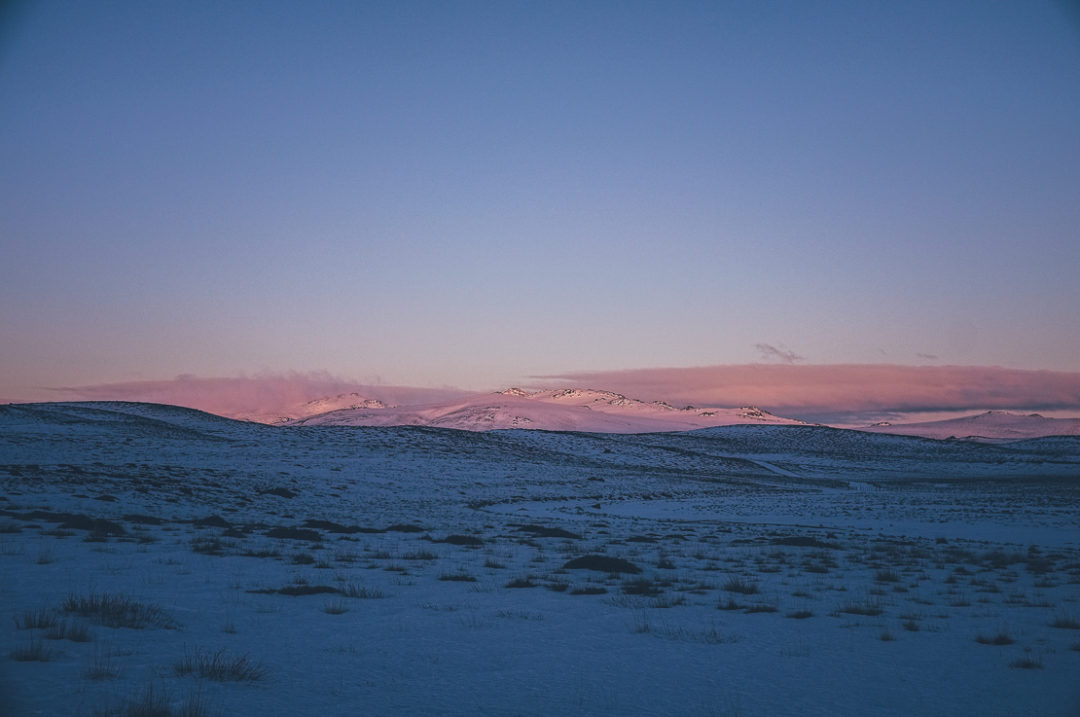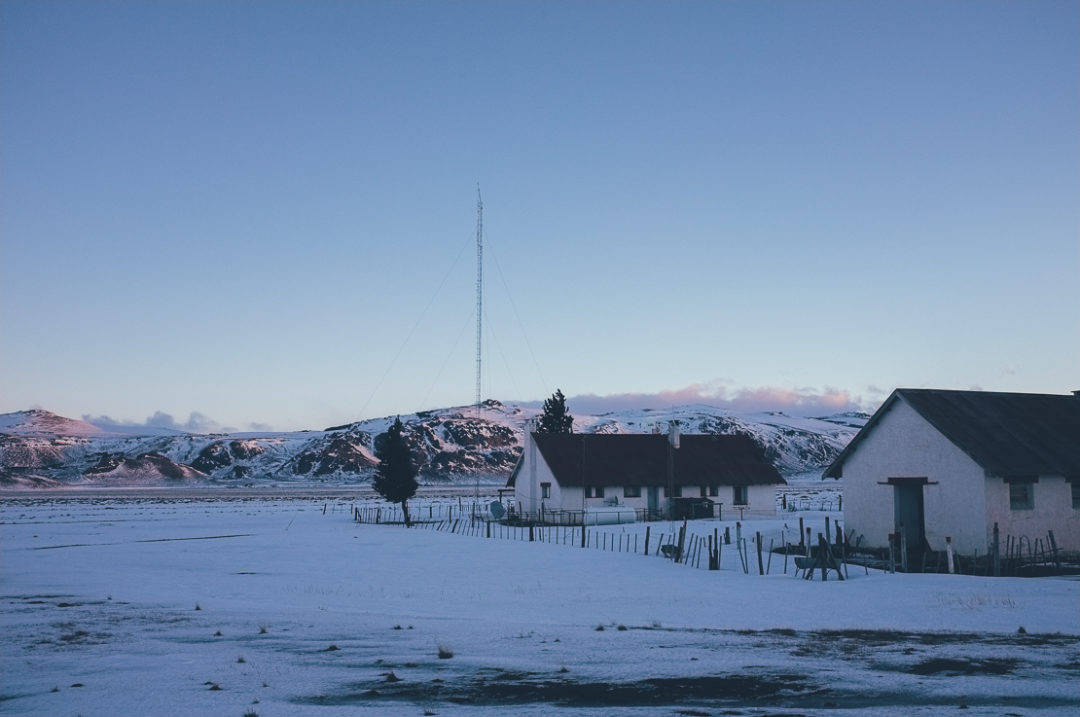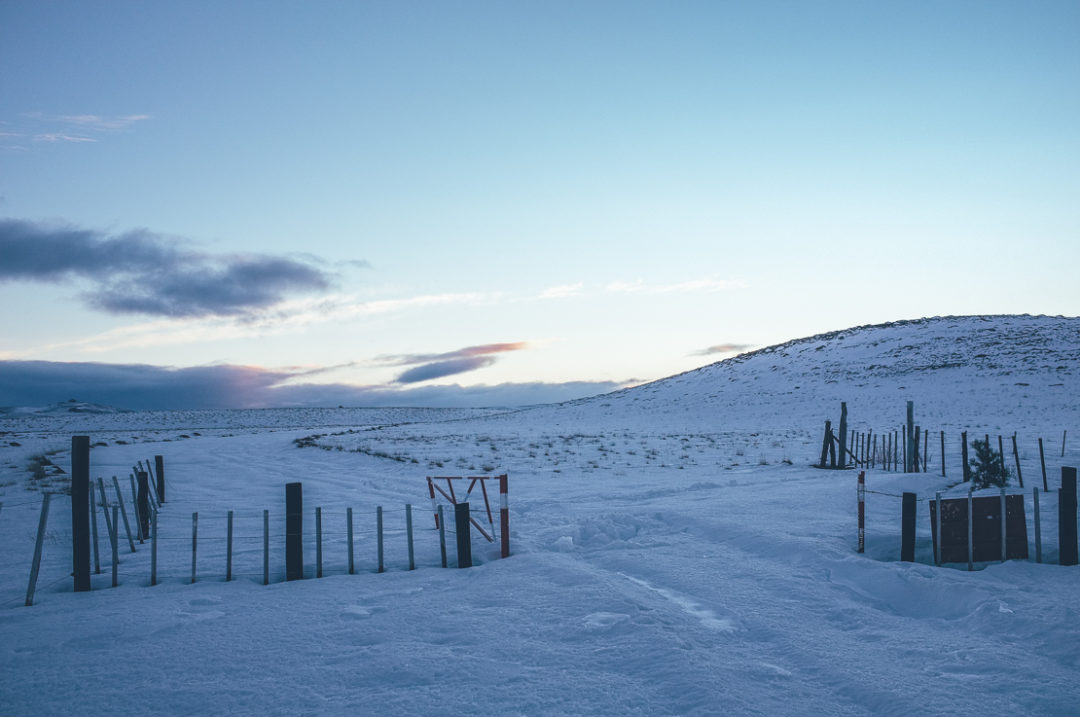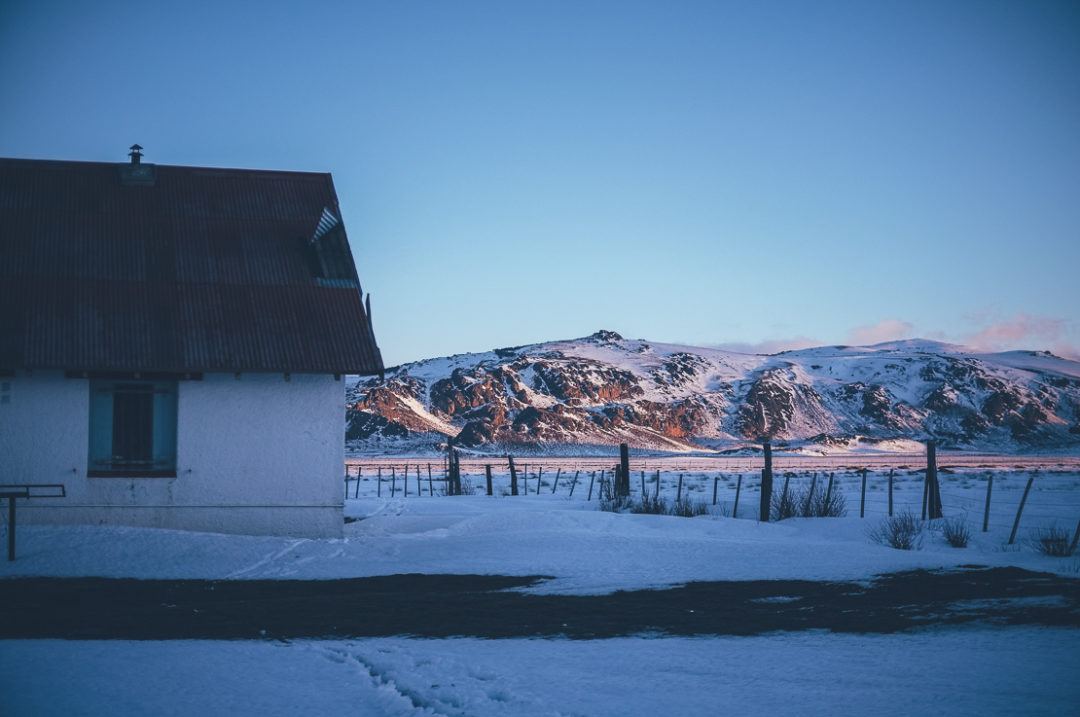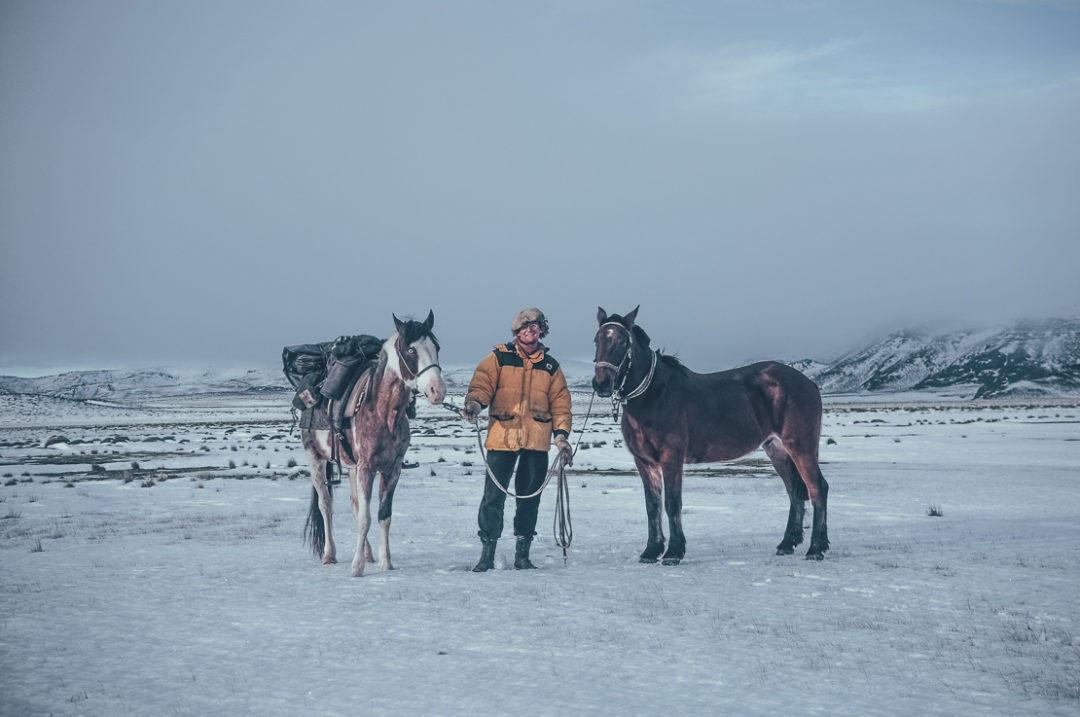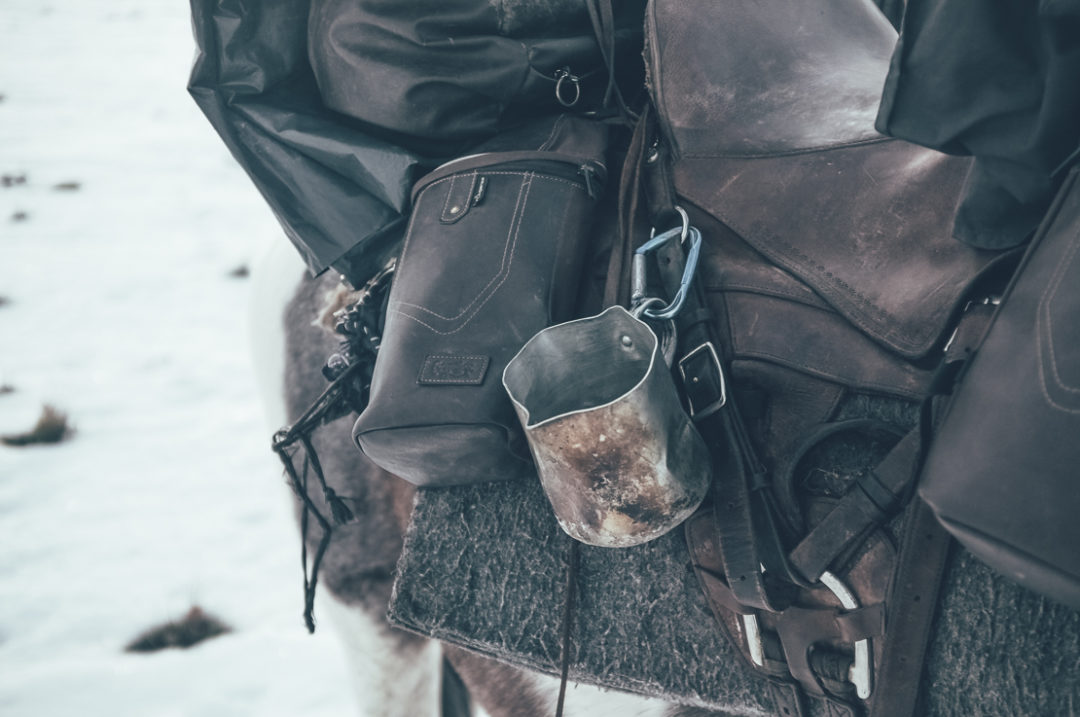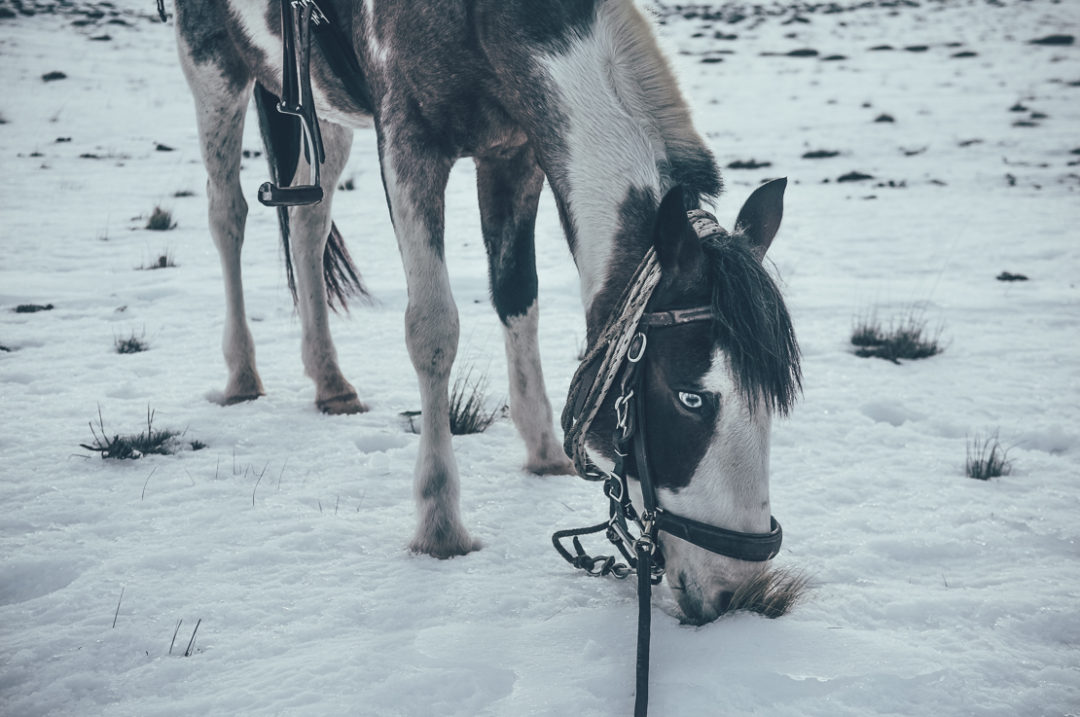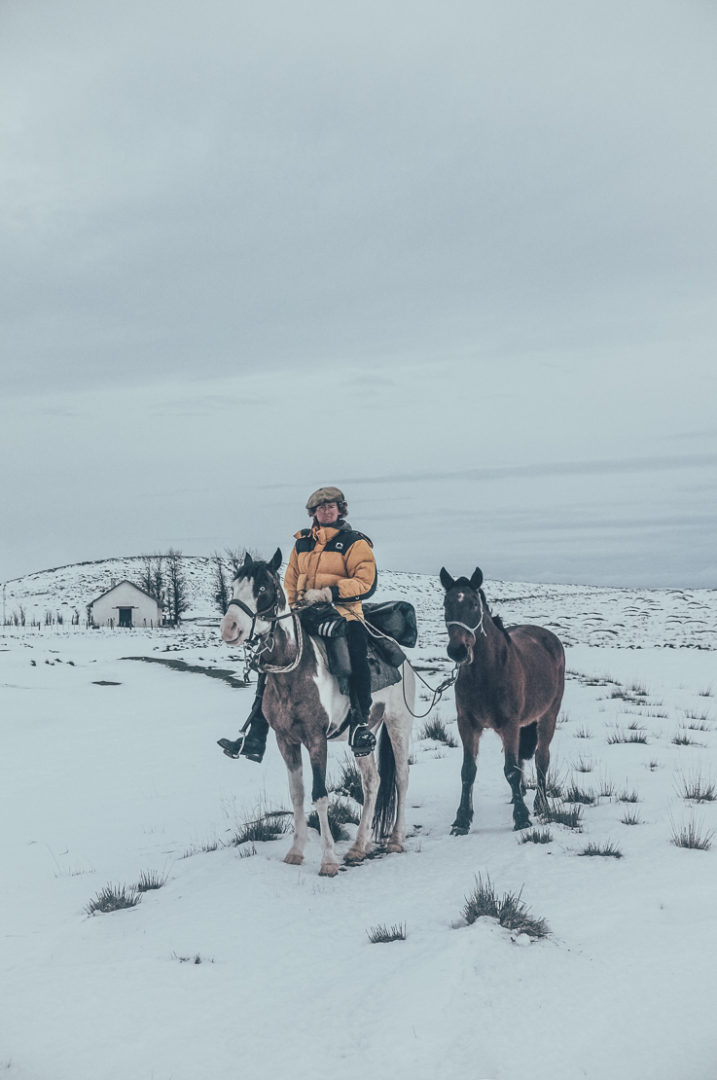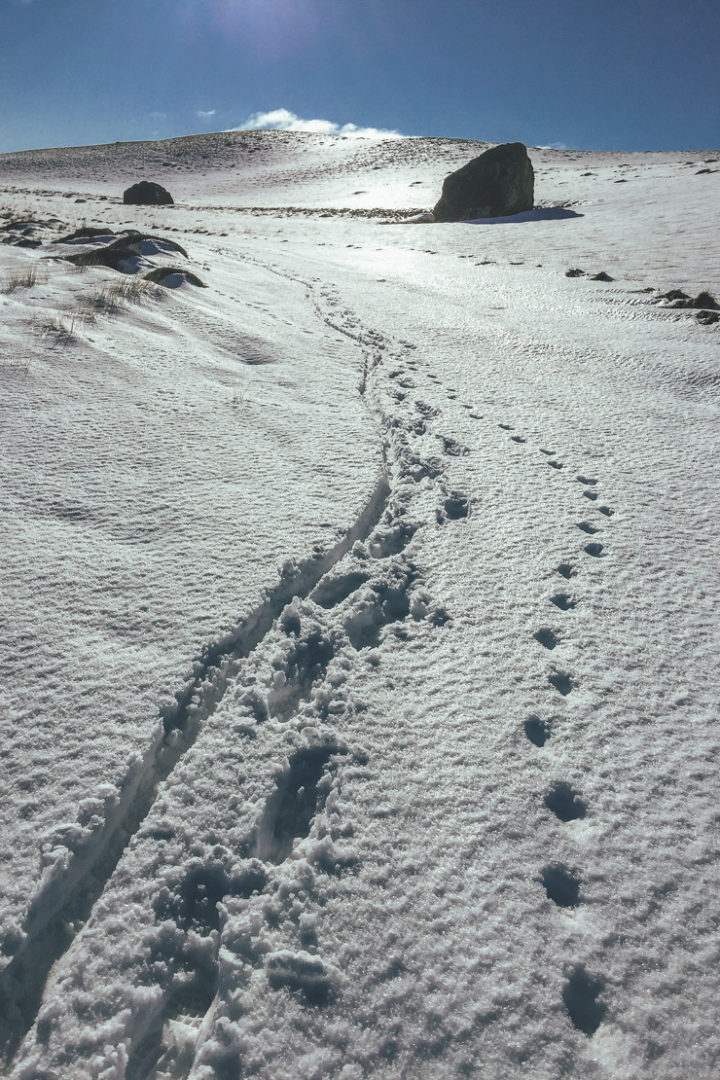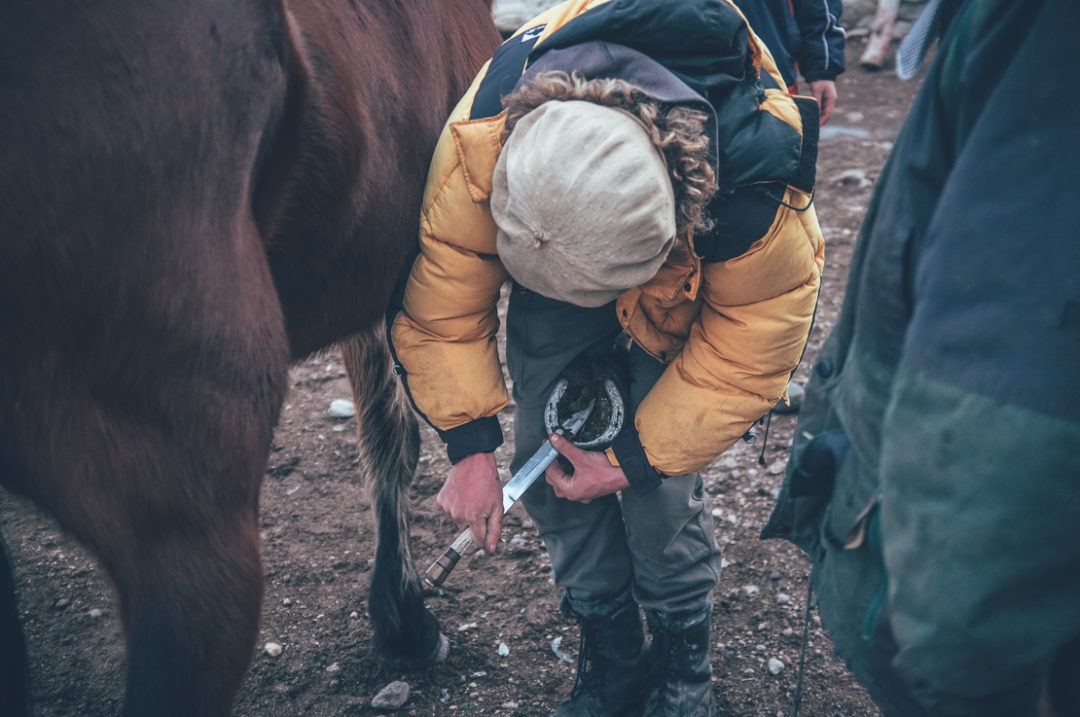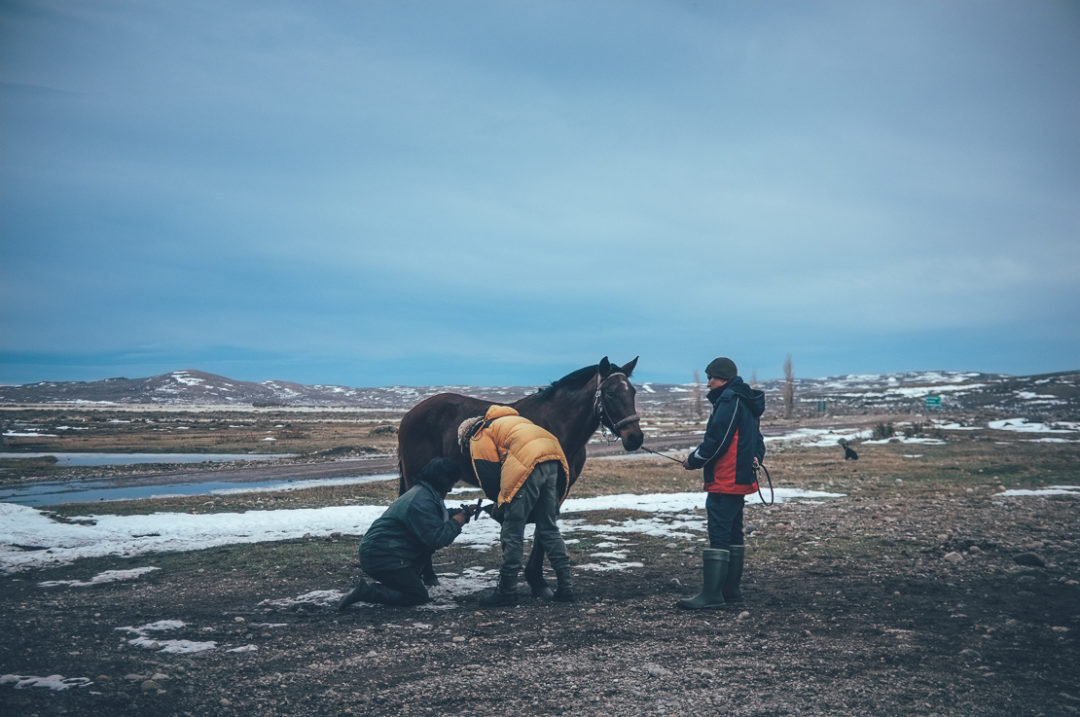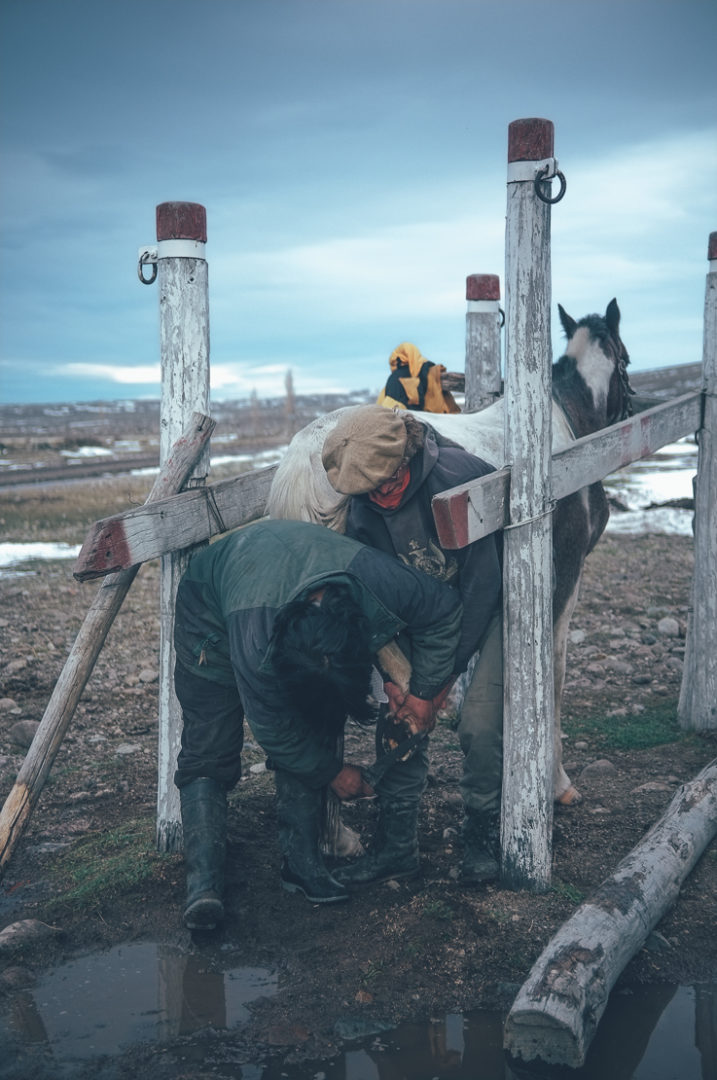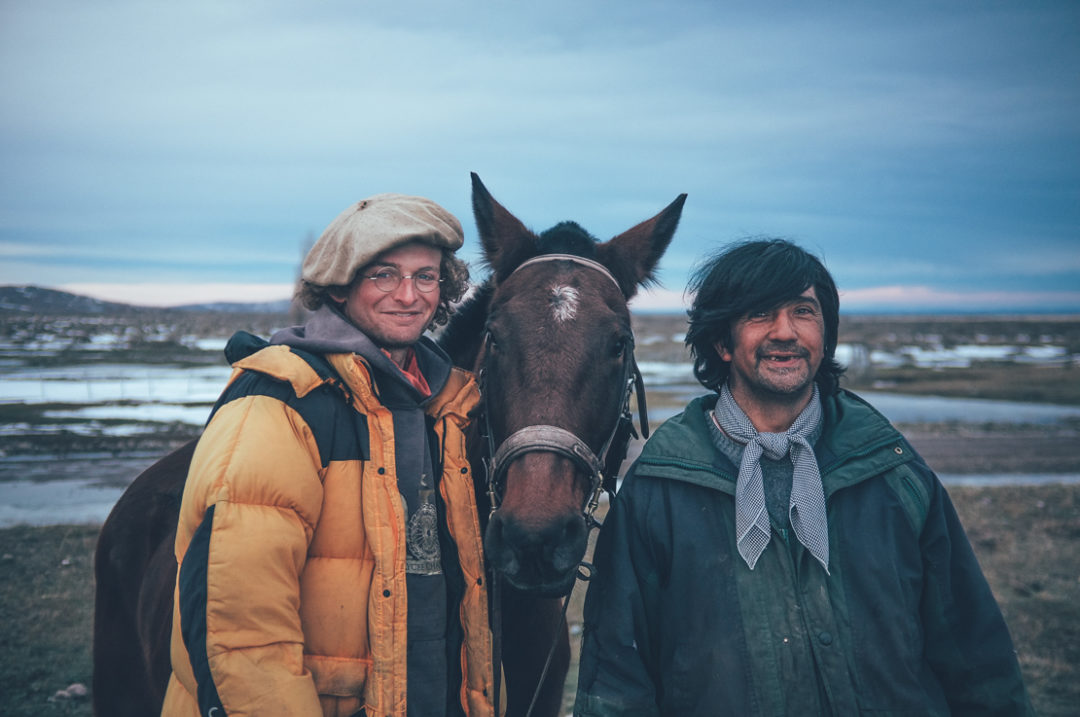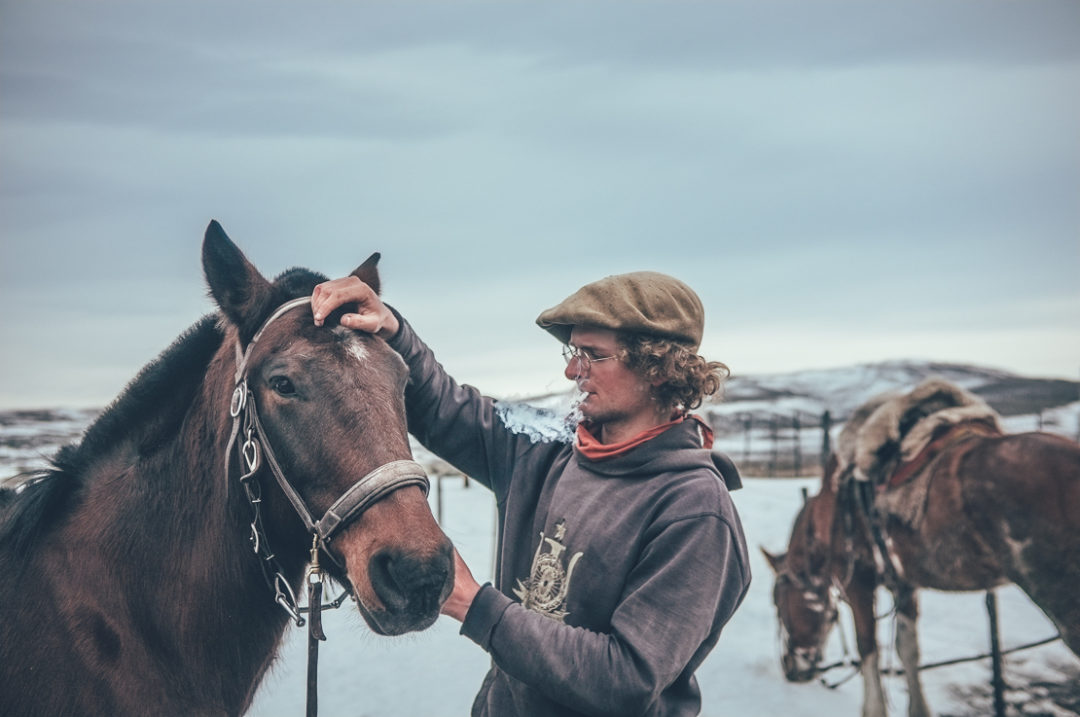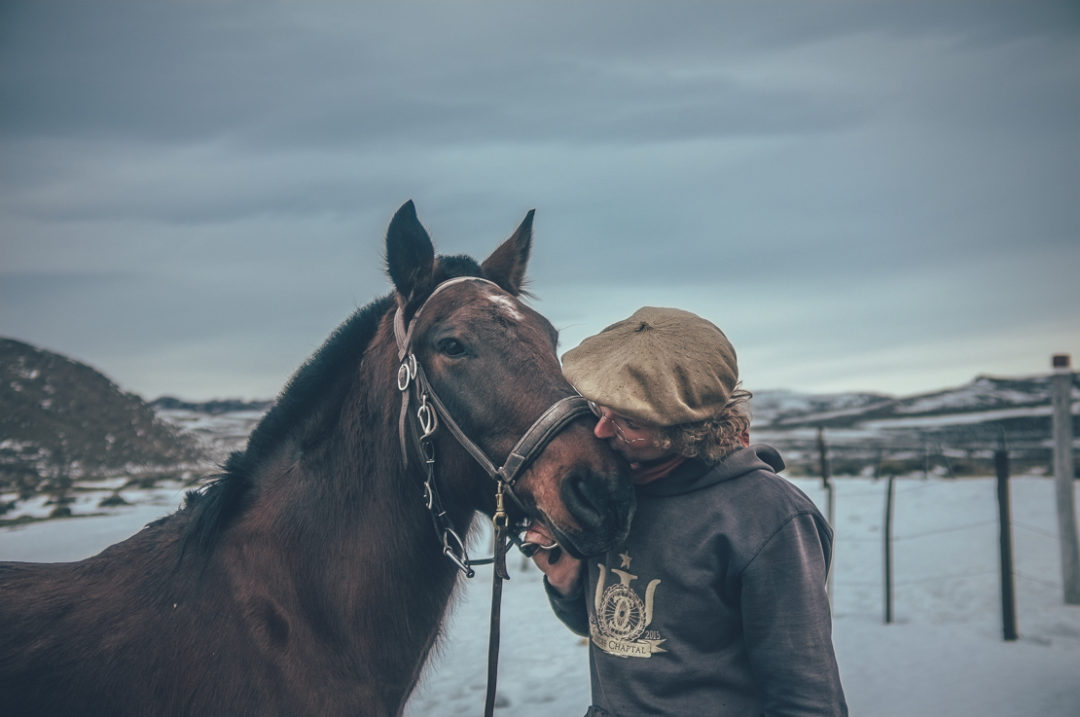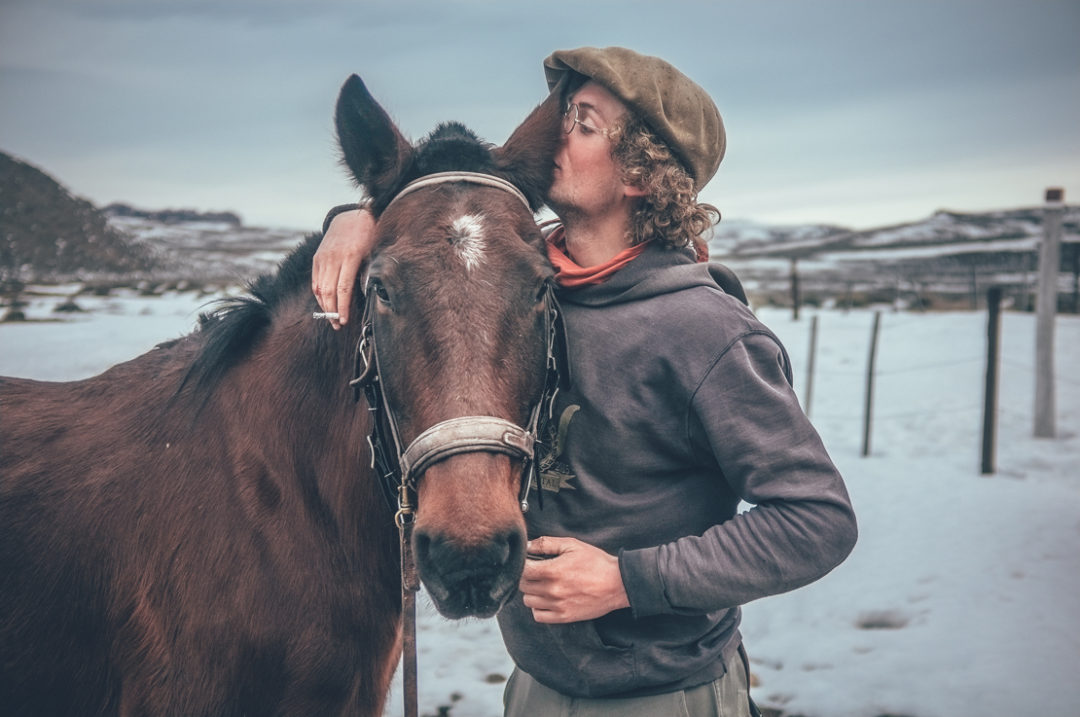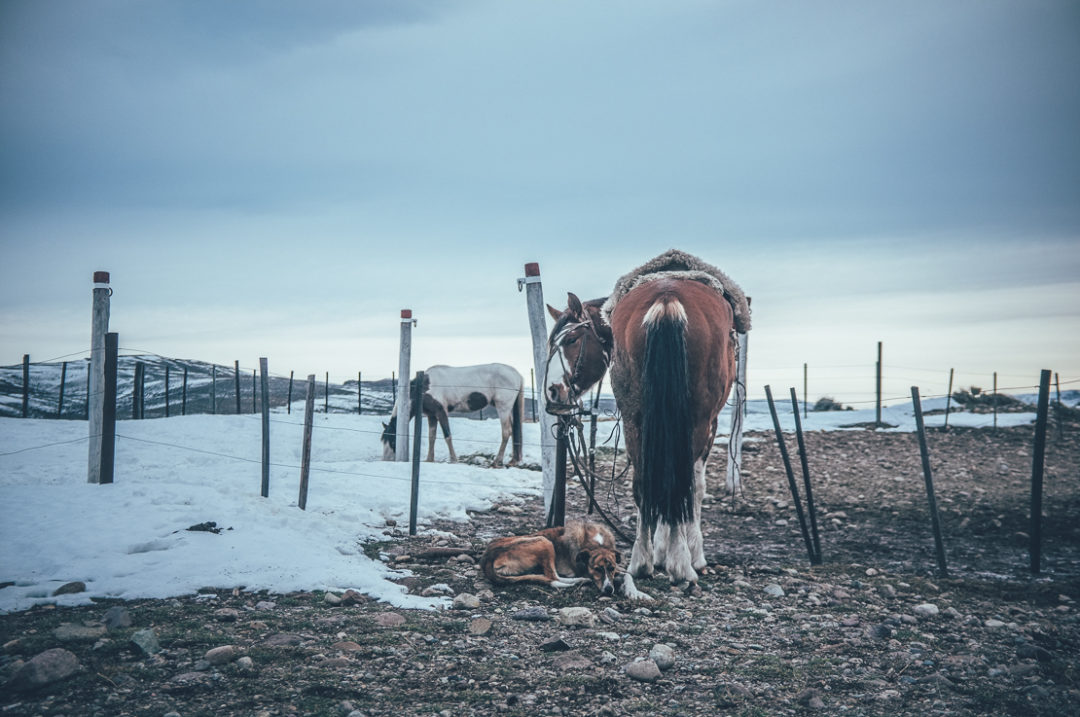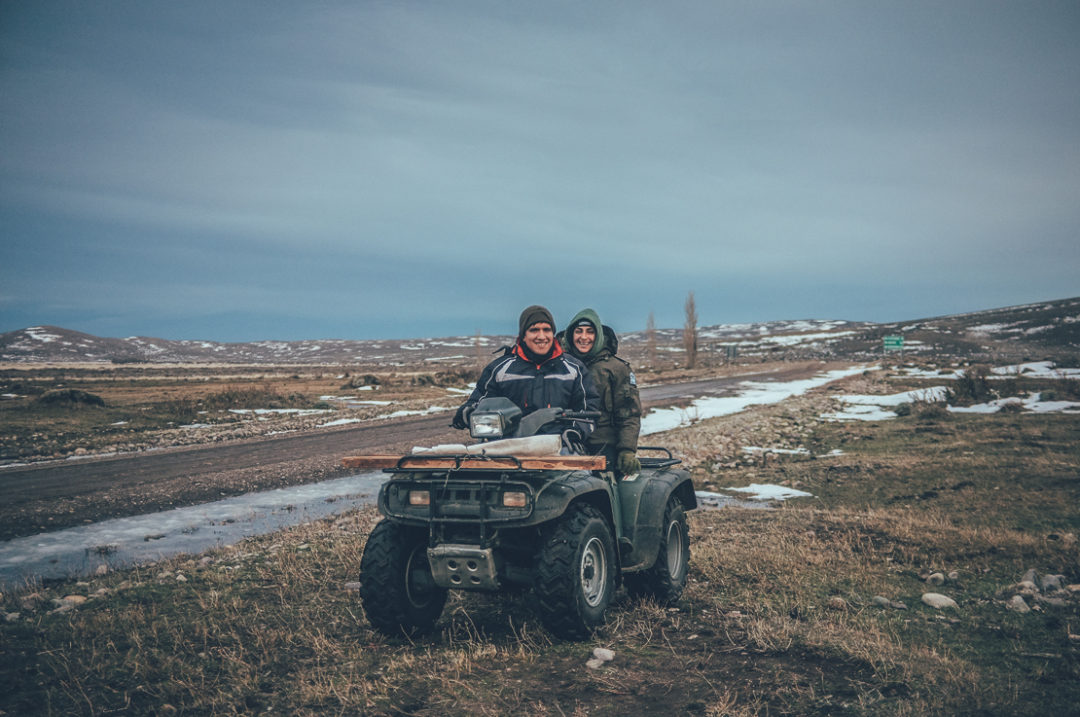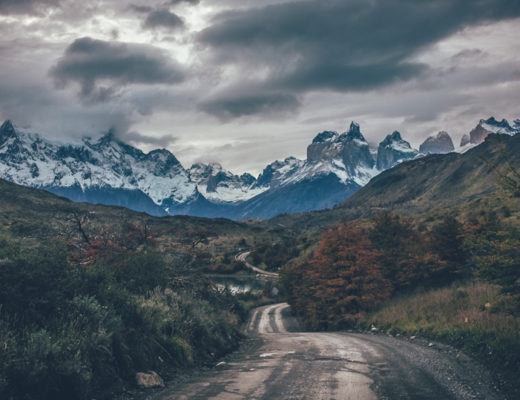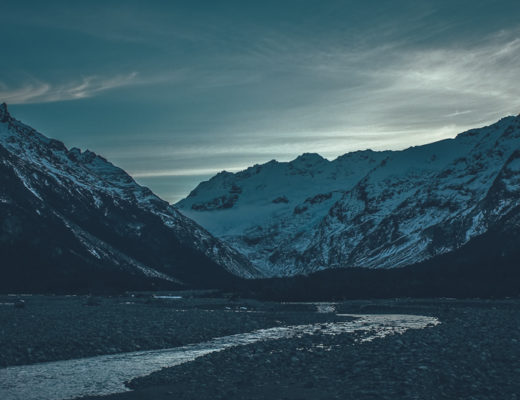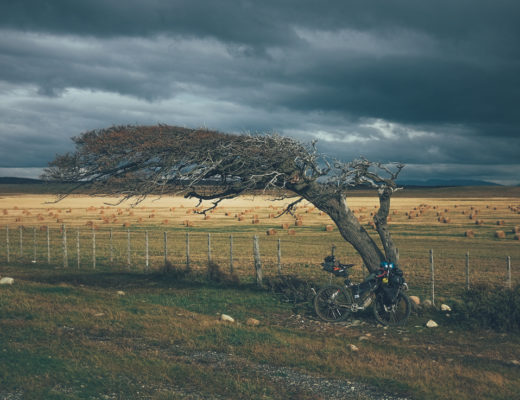It snowed, snowed and snowed. The local highway, Carretera Austral, was empty and the tiny village of Villa Amengual was silent. Everybody stayed put in their houses waiting for the snow to stop. In the news it said that it was the snowiest winter in the area for decades. In Finland 50 cm of snowfall is not that unusual, but here, much closer to equator at sea level it rarely snows heavily multiple consecutive days. I enjoyed the forced stop from cycling, but simultaneously the white scenery was inviting me for an adventure. And an adventure I got.
The following covers 138km from Villa Amengual (Chile) to Aldea Apeleg (Argentina).
Multiple days of heavy snowfall covered the valley around Villa Amengual with pure white blanket.
Two days after the snowing had stopped I stepped out from the Refugio para ciclistas, which had provided me shelter, company and food the past five days. It was sunny, but crisp. Perfect winter day really. Snow on the road was already hard packed and icy. In a day or two the main road would be like a skating rink. Luckily my route turned away from the Ruta 7 already after a couple of kilometers, towards the higher mountains and the border crossing of Paso Rio Frica at 910 meters. Locals had not managed to shear light if the road I was about to take would be yet open, but I was not about to twiddle my thumbs and wait for a green light. The road to the mountains seemed to have been in use for multiple days already, I saw once I reached it. Starting the climb toward the pass, the amount of snow also decreased rapidly. This would be way easier than expected.
Climbing toward the Paso Rio Frica from Villa Amengual.
At sunset I found a tiny refugio at 550m after 40 km of gentle climbing in the snow. The shack just a little longer than my mattress and I could see out through the walls and roof, but was still inviting. I would not need to work in the morning to get rid of the frozen condensation on my tent and there would be some protection from the wind as well. At night a thin layer of fresh snow had covered my tracks in snow to the tiny cabin and it also silenced the approach of a local gaucho, who was justifiably curious of me. Talking to me on the saddle of a horse, one and half times the size of the refugio, he checked that I was ok, wished me ‘suerte!‘, good luck, and kept going.
I reached the village of La Tapera after an hour of cycling. From the north side of the village, on the other side of the Rio Cisnes, was the start of one interesting alternative route to north to Lago Verde, which some cyclists had taken in the past. All I could see was a white mountain face, with no indication whatsoever where the trail could be. I had thought the snow could be blocking this route, so I had swallowed my disappointment already days ago. To Argentina I would go again. I expected the border crossing to be hard, so I bought an extra a couple of days food just in case. I also had plenty of petrol for my stove with me, as I did not expect to find water in a liquid form on my way.
I reached the Chilean border station at Estancia Rio Cisnes an hour before sunset, at 5pm. It did not make big difference to me where I would sleep, the scenery was flat, I would use snow as my source of water. Having learned the hospitality of the Chilean and Argentinian people, I secretly hoped though that the border officials would offer me a place to sleep. The invitation never came, even though they kept asking about my trip until it started to get dark outside. After posing in a picture with the Carabinieri I got on the bike toward the official border 17 km away.
Carabinieri at Paso Rio Fricas were pleased to see a tourist crossing the border in the winter.
After the border control snow was surprisingly uncleared, but riding was still possible on tire tracks. At dusk I saw a silhouette of a couple of trees and started to carry my bike away from the road toward them. From the other side of a barb wire fence, which separated me from this only wind cover in the area, the spot looked relatively perfect. Just when I was about to start to unload my bike to get it lifted over the fence, a horse appeared from the darkness and scared the shit out of me. A local gaucho had seen me from the road when riding home in the dark and come to invite me to his house for the night. My heart still beating 150 bpm I managed to accept the invitation. Having no experience with horses I find it incredible that people can travel high speed on their horses in complete darkness, relaying on the night vision ability of their animal.
The Gaucho named Jonathan was from Punta Arenas and had come to work for Estancia Rio Cisnes for the winter to gather money for a big dental operation. Third of his teeth were missing and he had left his family for the winter to take care of the cows of this remote ranch to finance a new row of chewing bones. His cabin was cold, but rather nice and simple. The food storage was full on flour, rice, pasta, cooking oil, tea and coffee. A meter of sausages hanged from the roof, away from the reach of hungry mice. He seemed happy and kept talking even though I understood only a fraction of what he was saying. He prepared a massive portion of dough, which he turned into triangle shape pieces of bread, which he fried in grease on the big wood burning kitchen stove in the room. Tortas fritas, fried bread was a Patagonian delicacy which seem to be in favour of people on both side of the border. Every triangle of fried bread weighed like it would have a small stone inside it and my fingers dripped warm oil when I stuffed the hot tortas in my mouth. Perfect winter food. I cooked my usual pasta with olive oil, cheese and some vegetables from the previous village and shared the portion with my host. My pasta got an acceptive nod and my new friend gave me a faint smile. We drank mate in the warmth of the big stove in the dark enjoying each others silent company, before wishing buenas noches and retrieving into our bunks.
In the puesto del gaucho. The maté was stored in a bag made of a beaver skin. Apparently keeps the grass -yerba- fresher than in containers made of other materials.
In the morning we repeated the routines of cooking and drank probably a litre of maté each before we got out into the snow to start our daily tasks. For me riding my bike and for Jonathan, counting the cows in the valley 5km away.
Jonathan ready to start his day at the Estancia Rio Cisnes, 9km from the Argentine border.
The temperature raised quickly over zero celsius in the strong sun when the midday approached and the snow on the road turned soft preventing me from riding. After a few kilometers it appeared, that a car which had been on the way to Argentina based on the prints on the road had got stocked in the deepening snow and forced to turn back to Chile. I had assumed the depth of snow to diminish when getting closer to Argentina, but the opposite seemed to be true. With no tire tracks to follow and the wet snow being occasionally 40cm deep, my progress slowed down. Pushing the bike in the snow was hard, I could occasionally progress only 10 meters before having to stop to rest for a short while.
Bienvenidos a Argentina at Paso Rio Frias.
At sunset I had progressed only 18 km, but the beautiful vast and empty sceneries and numerous footprints of puma had kept me entertained. I had prepared to dig a spot for my tent into the snow, but by pure luck there was a building in front of me when I needed shelter. I had arrived to Gendarmeria summer border post, which was empty during the winters. A quick look around showed that there was great wind protection in the horse stalls, but it was inhabited by a skunk family. Horse food storage at the entrance of the stalls was just big enough though to sleep in. The 30 minute sunset coloured the scenery pink and purple.
Sunset at the Gendarmeria summer puesto at the Paso Rio Frias.
After a walk in the area with my camera I returned to horse stalls to start my evening routines. I had been too busy seeing the world through my camera lens to notice a person approaching my camp with two horses. I saw him only when he was 30 meters away from me. Who would be so crazy to be here this time of year and why? I was not sure what I was seeing, there was a lot of something gaucho-like in the appearance of the person and there were two horses as well, but I had never seen a gaucho wearing a modern down jacket. I walked in deep snow to welcome the stranger.
Antoine started a one year horseback expedition, L’Expédition Helena, from Peru in late 2016 toward Tierra del Fuego, South Argentina. When we met he had been traveling south from one estancia to another with his two horses for nine months. Our routes crossed by pure luck in the most unlikely location, in the area accessible only by horse or walking at that specific moment, a days journey from the nearest village. We were likely the only people in the area and we had reached a same place, on the same day and at the same time.
I showed him the premises and after seeing the horse stalls he said ‘a paradise’. His horses had not eaten properly for a couple of days and the route he had taken in Argentina had had up to one meter of snow. The stalls provided some well needed protection for the horses for the night and we managed to find some hay for the horses as well, left behind by Gendarmeria in the summer. Skunks were not his concern. We made a big fire outside, cooked, shared stories and kept talking till midnight about the many differences of our ways of travelling.
The bond between him and his horses made me a deep impression. Antoine lives, eats and breaths according to the needs of his companions. Literally. He has been forced to become an expert of South American language, culture and customs. He travels without a tent and cooking equipment. He relies fully on the support of the hospitable gaucho culture and it’s wisdom of travelling on horseback in the wilderness, riding from a farm to farm. He would be willing to pay for he’s and his horses food, but the money is rarely accepted by his hosts.
Our trips could not be more different, even though our routes are partly similar. I can avoid human contact for a week, where he relies on it every night. I wake up when I feel like it and get on the bike when weather allows during the day. Antoine wakes up every day at the same time hours before sunrise to feed and saddle the horses and gets on horseback when still dark. I stop to eat, drink or rest when I am tired, he stops only when his horses need to.
Before he got started riding, we had a little photoshoot in the steppe. I thought he might not have many picture of himself with his horses, like I do not have many on my bike. He was more than happy to try to make his companions to stay still for a while for a picture.
Early morning at the summer border station of Gendarmeria at the Paso Rio Fricas, Argentina.
We had 24 km to the first village in Argentina, Aldea Apeleg, which would mean a full days ride snow for Antoine and a full day of pushing for me. If I had max 40 cm snow on my route before, now there were sections with a full meter of snow. I found myself waist deep stuck a couple of times, using all my creative powers to find a way to progress without exhausting myself.
Occasionally, instead of following the footprints of L’Expédition Helena I followed the tracks of a puma, who seem to know where the cover of snow was the thinnest. Within the 10km from the Gendarmeria post I must have seen dozen or so puma footprints in snow. Big ones, small ones, couples and families. Still not a sign of the actual animal, even though I kept my eyes in the surrounding hills trying to spot any movement.
Occasionally the numerous footprints of a puma showed me the best way to progress in the snow.
After 15km I reached a crossroad to a habited estancia, where onwards the road was rideable again. At sunset I reached the village and found myself to a local police station when trying to find where Antoine was staying in the village. The police officer welcomed me to his home, gave me three big slices of pizza and prepared me a massive glass of vodka and Sprite, before heading out to look for my new friend and his horses. He come back 20 minutes later and told me to follow him. I rode my bike behind his truck to the community house, where I found Antoine in the sleeping quarters. We could sleep there the night and the following ones as well, if we felt like it. The ride in the deep snow had been hard for his horses as well and they needed a good rest, a lot of good food and new shoes. I was in need of rest as well, as two full days of pushing my bike had created a pain in my right knee. Later in the evening we were collected by Gendarmeria by a squad for a dinner, even though the Gendarmeria post was just a kilometre away. The following morning Antoine had woken up early to get his horses reshued. A local horse shoer had come to the village to help him out. When I woke up I joined them with a camera in my hand.
Tire change version a lá L’Expédition Helena.
Antoine was unfortunately forced to finish his trip already soon after our encounter due to the grave sickness that faced his horse. Somebody else could have changed the horse and force the completion of the expedition. Not Antoine. True man is not one who reaches his selfish goals, but the one who returns home knowing he tried his best within the limitations of himself and his companions. Congratulations Antoine for finishing your great adventure! Nos vemos algún dia!
Some people have kids, some have horses. At the Gendarmeria of Aldea Adeleg.
These happy faces of Gendarmeria welcomed me and Antoine to their tiny frontier village and provided us with whatever we needed! Muchas gracias por todo!
The Route
In the summer this 140km section of gravel road is a rather easy ride. Traffic between villages keeps the road hard packed, maybe excluding the wettest times of the year. No need for bigger tires than 2″. In the winter, though, snow might be blocking the road despite the border crossing of Paso Rio Frias being technically open full year round. My original plan had been to take the route from La Tapera north to Lago Verde, but the route had a half a meter of snow when I was in the area. Based on some pictures online by other long distance haulers, that is the route to take, if you are going through the region on snowless time.

